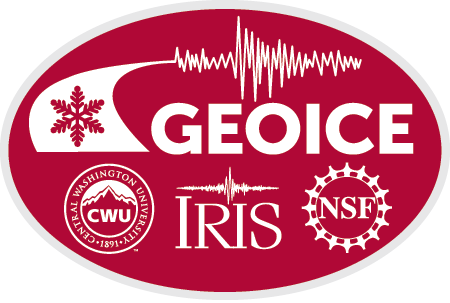GEOICE
|
The Geophysical Earth Observatory for Ice-Covered Environments (GEOICE) project was a NSF collaborative Major Research Instrumentation (MRI) program that expanded the EPIC Polar group’s observational capabilities and logistical efficiencies. GEOICE developed a rapidly deployable, dense footprint seismic observatory system for operation in ice-covered areas. The GEOICE project was a collaborative effort between Central Washington University (CWU), Incorporated Research Institutions for Seismology (EarthScope) and the Portable Array Seismic Studies of the Continental Lithosphere (EPIC) Instrument Center at the New Mexico Institute of Mining and Technology. |
 |
PIs and Institutions
|
Dr. J. Paul Winberry Dr. Audrey Huerta |
|
|
Dr. Robert Woodward Kent Anderson |
|
|
Dr. Susan Bilek Dr. Bruce Beaudoin |
Results
Several of the proposal goals were realized including:
-
Incorporating and expanding the mixed-mode instrumentation in the polar pool
-
Pursuing “All-in-one” seismographs that integrate the seismometer and data logger in to a single housing
-
Reducing system power consumption to reduce logistical needs and increase deployment duration
-
Investigate technologies to optimize battery weight to power ratio
GEOICE Equipment Pool
| Instrument | Manufacturer | Type | Qty | GEOICE Target Frequencies* | Operational Temperature |
|---|---|---|---|---|---|
| Trillium 120PHQx | Nanometrics |
Posthole Broadband |
10 | 120s-100Hz | -400C to + 600C |
| Trillium Compact PH | Nanometrics | Compact Posthole Broadband | 55 | 50s-100Hz | -400C to + 600C |
| Centaur | Nanometrics | Data Logger | 65 | -400C to + 600C | |
| Zland 3C | Magseis FairfieldNodal | Short Period Node | 200 | 1s-500Hz | -400C to + 600C |
*Nominal design-goal frequency band when used in conjunction with other GEOICE array components - actual instrument specifications may extend outside these ranges
Requesting Instruments
GEOICE instrumentation is available via the standard EPIC instrument request process. To get started on a new instrument request, please visit Experiment Scheduling.
Station Designs
-
Roadrunner (Centaur summer quick deploy) station
-
Design drawings ready for further expansion
-
-
Power expansion boxes
-
Prototype builds showed proof of concept
-
Design drawings of prototype systems could easily be revised into production systems
-
Ancillary
-
Development of a portable system for the Magseis FairfieldNodal ZLand 3C charging and harvesting rack and server
-
Development of a Trillium Compact Posthole shipping case
-
Testing of DC-DC converter to facilitate the use of non-Polar rated battery technology on or near temperate glaciers or in sub-Polar regions
GEOICE Research and Testing
-
Summer and winter over in field testing of LiFePO4 batteries in Alaska and Antarctica
-
Small format AGM and LiFePO4 batteries for summer stations with Power expansion boxes to convert to winter over stations in sub-polar or temperate locations
-
Allows for logistical flexible and scalable station deployments and servicing
-
5 different battery chemistries (3 primary, 2 secondary) for power expansion boxes allow for flexibility of logistics, near field sourcing, extreme reduced weight and volume or wider use robustness
-
AGM, LiFePO4, Li-TC, Aircell, Alkaline
-
-
-
DC-DC Converter allowed battery chemistries that have suboptimal cold performance to operate winter over around temperate glaciers and sub-polar environments
Acknowledgements
|
GEOICE was funded by the National Science Foundation under awards PLR-1337861 to EarthScope, and PLR-1337548 to Central Washington University. Both awards were entitled "Collaborative MRI: Development of Geophysical Earth Observatory for Ice Covered Environments (GEOICE)" |
|
 |
 |
 |
- Home
- General Information
- Instrumentation
- Dataloggers
- Sensors
- All-In-One Systems
- Power Systems
- Field Procedures
- Controlled Sources
- Seismic Source Facility
- Magnetotelluric Systems at EPIC
- Ground Penetrating Radar
- GNSS/GPS Receivers
- Power and Memory Calculations Form
- Data Archiving
- Apply for a PI Account
- Experiment Scheduling
- Polar
- Hardware & Software Notes
- Software



